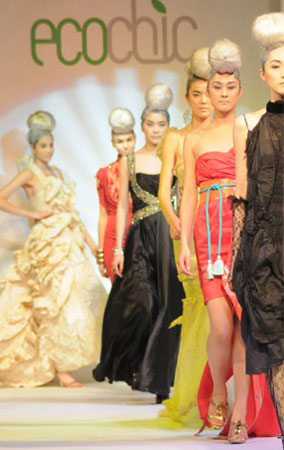By
Reuters
Reuters
Published
Jan 24, 2010
Jan 24, 2010
Eco-chic fashion shows off stylish sustainability
By
Reuters
Reuters
Published
Jan 24, 2010
Jan 24, 2010
GENEVA (Reuters Life!) - Models wearing alpaca fiber, bamboo and organic silk and cotton strutted down an "Eco-chic" catwalk to back a United Nations call for the sustainable use of natural resources.
 Photo: www.green2greener.com |
Nearly 50 ready-to-wear and couture designers from 40 countries displayed sleek garments in the Thursday (21 January) night show that ushered in the International Year of Biodiversity in the middle of the autumn/winter catwalk season under way in Milan, Paris, London and New York.
"We have chosen from the best in the world, the best in design, the best in ethics and the best in sustainable practices," organizer Christina Dean of the Hong Kong-based charity Green2greener told the Geneva audience.
Peter Ingwersen, a Danish fashion designer whose label "Noir" uses organic cotton fabrics from Uganda, said that consumers were increasingly concerned about the environmental and social impact of their retail purchases.
"Ten years ago it was enough to buy the latest 'it' bag. Today that's not enough anymore. You also want to know how it was produced," he said. "That is the biggest change that we've seen in our business since the hem-lengths went below the knee."
Ingwersen's 100 percent organic black dress, made from cotton grown without pesticides, was on view alongside donated items from top designers Thakoon Panichgul of Thailand, New York's Diane Von Furstenberg and India's Manish Arora.
A fair trade black and white short silk dress by Edun, the ecological and ethical fashion start-up founded by Irish singer and campaigner Bono, and a pink flower-studded hemp and silk long dress by Brazil's Alexandre Herchcovitch also featured.
WHAT TO WEAR?
Concerns about climate change, loss of biodiversity and weak labor standards in textiles, particularly in Asia, have raised buyers' awareness.
Some conventional processes such as scouring wool, tanning leather and bleaching, dyeing and printing fabrics use large amounts of water, energy or toxic chemicals, and emit effluents.
The fashion industry has responded to demand for sustainable styles and natural fibers that look good, said Lucas Assuncao of the U.N. Conference on Trade and Development, known as UNCTAD.
Eco-fashion now draws in between $150 million and $200 million in sales per year, "an increasingly significant chunk of the market," he told a news briefing.
British designer Sarah Ratty of Ciel uses a broad spectrum of fabrics that are natural fibers or environmentally produced, many of which are not yet on the radar of most consumers.
"A lot of people when they think of green fashion only think of organic cotton. But there are also a lot of other fibers that we can use like hemp silks, a very green fabric that gives back nitrogen to the soil," she said.
Anggy Haif, an Eco-Couture designer from Cameroon, has worked for 10 years with natural fibers including raffia, tree bark and wild seeds collected in the forest.
"I started because I saw that in my country modern textiles had overtaken traditional fabrics which were disappearing. It was to revive local artisanship," he said. "Today the market is in very good shape in my country and is spreading in Africa."
But the Danish designer Ingwersen said that green fashion could flame out unless consumers find goods they want to wear.
"If we don't inspire our fellow designers, the end-user and fashion media, then this is going to die within two, three years. It will just have been a really fast fashion fad."
(Editing by Laura MacInnis and Paul Casciato)
© Thomson Reuters 2024 All rights reserved.

























